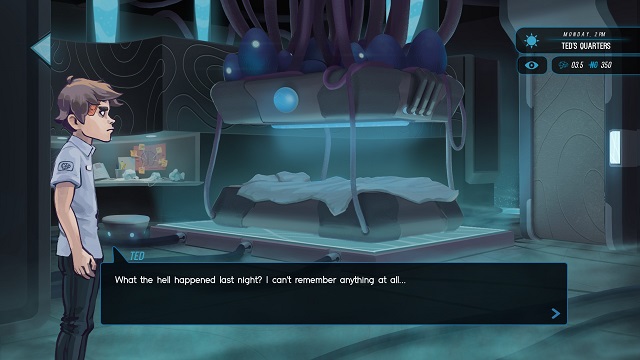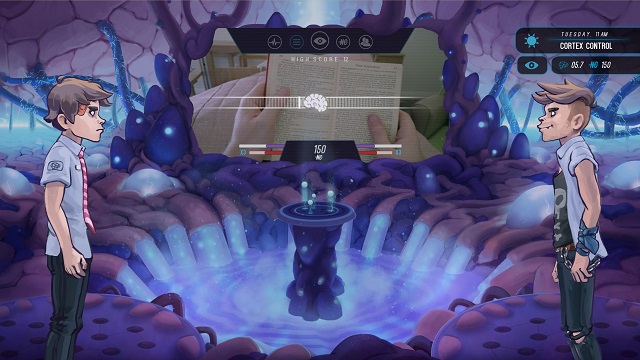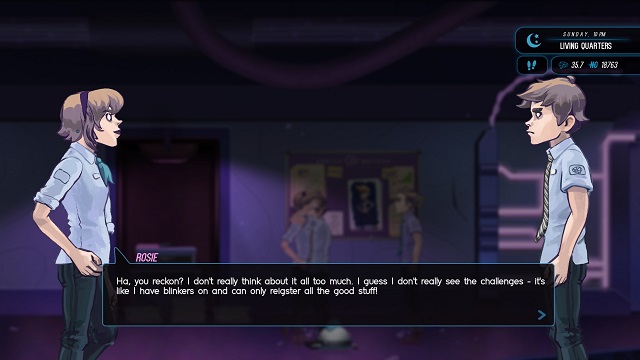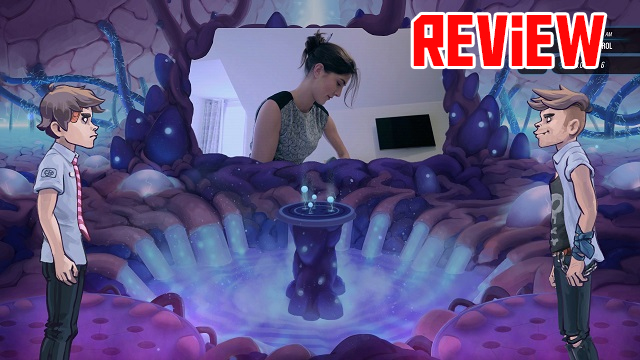It was bound to happen. After years of new FMV releases that outdo their forebears, we have an FMV release that reminds us why we wanted them gone in the first place. HEADSPUN is just barely an FMV game, using its movie segments to prop up a narrative-focused business tycoon that never truly gets off the ground. Published by Wales Interactive and developed by the new team at Superstring, it is hard to come up with anything positive. No matter if you’re in it for its unique premise, its FMV storytelling or its strategy elements, Headspun disappoints at every turn.
Headspun Review | Five weeks will give you such a crick in the neck

In Headspun, You awaken as Ted, one of the few remaining workers of Cortex, which is a business that runs the brain of the human, Theo. Think Pixar’s Inside Out but with a lot less personality and no Amy Poehler. Ted runs the left half of the brain as a straight-laced, business-minded overseer. He works alongside Teddy, a rebellious type that’s in charge of the right brain. As you wake up with amnesia, you discover that Theo got into a car accident and shares your memory loss. As Theo stays in the hospital, you have to repair Cortex and restore Theo’s memories to discover exactly what happened the night of the wreck.
That’s a great premise for a game. You only see the outside world through Cortex’s control room as an FMV scene. The rest of the brain exists as a 2D animated space, drawing a sharp divide between the real world and Ted’s metaphorical existence. The only problem with this setup is that it seems designed specifically to limit the FMV portion of the game. The scenes all take place in one location and only occur when you’re working your day shift in the control room. Even then, you usually see a generic static shot unless a story scene pops up.
And “working a day shift,” really means working a day shift. The main gameplay of Headspun for more than half the game involves tiny tasks to earn currency. More than dialogue choices or exploring Cortex, your main objective is usually completing minigames. There are several choices, including mashing buttons to imitate lifting weights and hitting a button at a certain time à la a golf game. However, no matter what you pick, it all feels like lame busywork. Choosing to take a nap over completing crossword puzzles doesn’t affect anything in the grand scheme of things. By the end, it’s worth to just skip through days that didn’t feature any story content.
Headspun Review | Breaking the memory bank

You’d think that the point of these games would be to earn differing amounts of currency. Making bank is certainly the intended goal, but Headspun‘s economy is completely broken. You make so much money that you’re quickly able to invest in things faster than the game can throw them at you. After two or three days of completing puzzles, I had enough currency to raise my daily allowance so high that I never had to worry about anything again. As soon as I saw an available upgrade, I immediately grabbed it without thinking. Less than halfway through my playthrough, the process became automatic.
This isn’t some side system either. There’s a significant chunk of Headspun that just falls apart as you play. I was upgrading so fast that some story side quests completely broke, playing each part for me in a sequence because I was so far ahead of the game. This compounds on some of the general lack of polish surrounding the experience. Menus don’t wrap around when you go left to right, leaving you hitting way too many buttons to navigate anywhere. Subtitles will often play before or after dialogue, and they sometimes linger on screen for minutes on end. Characters can overlap each other in the control room and character portraits sometimes just don’t show up during dialogue.
All those issues are secondary to one of Headspun‘s biggest problems. Because of its dual nature as an FMV adventure with management elements labeled on top, neither the keyboard and mouse or gamepad seemed to fit my playstyle. Navigating Cortex and the currency minigames are best on a controller, but navigating menus was a chore with anything but the mouse. I was constantly switching throughout my playthrough, which really gives me pause about playing the game with just one control scheme over the other. Basically, if you have to play Headspun, do it on PC where you have the full options available.
Headspun Review | Suffering from dissociative narrative

A good narrative would be worth mentioning by now, as it can soften the blow of abrasive mechanics and clunky systems. But it’s not good, despite the decent concept of the FMV and Theo’s stoy. Sadly, even with the best of intentions, Headspun doesn’t deliver here either. Rather than tell a full story, Headspun instead has a single twist locked and loaded from the get-go. It is a good twist, but it’s not a surprising one if you’re paying attention. On top of that, there’s just not a lot of conflict, and you don’t have much say in any of the goings-on.
For example, there are several occasions where you get multiple options during an FMV conversation. This is you commanding Theo to speak, so there should be some variance and some fun to be had. Instead, Headspun railroads you through every conversation and you have to pick every choice. Your only action is to choose which order the questions play out it, leaving you to guess the intended flow and risk confusion at the story structure. It’s counter to everything good about the adventure genre, and the story they’re telling doesn’t justify this deviance from the genre.
Headspun Review | Seeing the light

There are hardly any redeeming factors here but the score features some appropriately new wave synth sounds considering the subject matter. While the tunes are great, the audio balancing was way off by default, drowning out the dialogue in FMV scenes. The art is pleasant and appropriate as well, with each character being a slight tweak on what Theo probably looks like out of the third-person. It would just be much better if anyone outside of the main three or four characters in Cortex had anything to do outside of spouting a handful of preset conversations.
Alas, that’s the story of Headspun. For every spark of a neuron, there’s a cluster of dead cells threatening to snuff it out. The entire enterprise feels like a bundle of great ideas that mix together into something that’s less than the sum of its parts. Managing workers in a brain would be interesting if the conversations had depth and the economy worked. An FMV adventure about a hospital-bound amnesiac could certainly work, especially if they expanded on their own twist. The end result gives a lackluster attempt at both its genres, and that’s a shame. Instead of an illuminating revelation of emergent gameplay, all Headspun managed to give me was a headache.
GameRevolution reviewed Headspun on PC via Steam with a code provided by the publisher.
-
Great synthwave tunes that only occasionally overwhelm dialogue.
-
Clever artwork that compliments a great premise.
-
A twist unsupported by any narrative backing.
-
Completely broken economy and upgrade system.
-
Lack of polish in menus and control scheme.
-
Limited FMV scenes with little player interaction.







